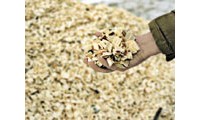Advertisement
Grab your lab coat. Let's get started
Welcome!
Welcome!
Create an account below to get 6 C&EN articles per month, receive newsletters and more - all free.
It seems this is your first time logging in online. Please enter the following information to continue.
As an ACS member you automatically get access to this site. All we need is few more details to create your reading experience.
Not you? Sign in with a different account.
Not you? Sign in with a different account.
ERROR 1
ERROR 1
ERROR 2
ERROR 2
ERROR 2
ERROR 2
ERROR 2
Password and Confirm password must match.
If you have an ACS member number, please enter it here so we can link this account to your membership. (optional)
ERROR 2
ACS values your privacy. By submitting your information, you are gaining access to C&EN and subscribing to our weekly newsletter. We use the information you provide to make your reading experience better, and we will never sell your data to third party members.
Environment
Biomass To Bioenergy
by Jeff Johnson
August 28, 2006
| A version of this story appeared in
Volume 84, Issue 35
COVER STORY
Biomass To Bioenergy
Beyond Corn
James D. McMillan has a vision: It is a biomass refinery where cellulose and hemicellulose in engineered crops are broken down by designer enzymes; glucose, xylose, and other sugars are captured and fermented into ethanol and valuable chemical feedstocks; and lignin, the tough stuff that holds a plant together, is burned for energy to run the plant.
It may be a dream right now, but it is one that McMillan spends each day trying to make real. McMillan is a biochemical engineer and manager of bioprocess R&D in the National Bioenergy Center, part of the National Renewable Energy Laboratory (NREL).
"The driver behind this is gasoline displacement," he explains. "Biomass is the only source of renewable fuel with the potential to displace large amounts of gasoline."

Today the U.S. produces each year about 5 billion gal of ethanol from corn kernels, and to do this, it takes about 17% of the nation's corn crop, most of which goes to feed cows. The cows-versus-cars competition would limit U.S. ethanol production from corn kernels to about 10 billion to 15 billion gal, McMillan estimates.
Last year's national energy act set a target of 7.5 billion gal of ethanol by 2012, and the Energy Department's stated goal of replacing 30% of current gasoline with nonfossil petroleum by 2030 would require some 60 billion gal of ethanol per year, McMillan says.
"We have to move beyond corn kernels and also start using corn stalks and cobs, straw, forest slash, and ultimately 'energy crops,' genetically modified plants specifically engineered for bioenergy applications," McMillan says.
Plant biomass, he says, is approximately 15-20% lignin, 23-32% hemicellulose, and 38-50% cellulose. Hemicellulose and cellulose carry the sugars needed to ferment to ethanol. But each has a problem, McMillan notes.
Cellulose is a fibrous material, and the sugars are hard to capture as they are held tightly, but it is entirely made of glucose, a six-carbon sugar that is easily fermented.
Hemicellulose, however, is mostly xylose as well as a mix of other sugars, which are easier to capture but are harder to ferment. Some, like xylose, are five-carbon molecules and less familiar to processors than glucose and more difficult to convert to alcohol.
Hence, McMillan says, NREL is trying to develop improved enzymes to chemically separate glucose from cellulose and new yeasts and microbes to more quickly and efficiently ferment the mix of five-carbon and six-carbon sugars found in cellulosic material, particularly hemicellulose.
Currently, no U.S. factory uses cellulose to make ethanol. Instead most process corn kernels, capturing sugar from starch, an easier technology with a long association with humans through alcohol production. But several companies have said they intend to use cellulose for ethanol; the feedstock is cheap, but the process is expensive and complicated.
"These companies feel they can make a buck using cellulose, and that is just great. But with current technologies, they are unlikely to reach anywhere near the 60-plus billion-gal target," McMillan says.
NREL's research, he stresses, is for the long term. He wants to accelerate the speed and increase the efficiency of fermentation, greatly increase the yield of sugars from cellulose and hemicellulose, and reduce the amount of enzyme needed in the process by an order of magnitude. The lab is also examining better ways to combine chemical and enzymatic extraction of sugars with the fermentation process.
NREL is also involved in biomass research to develop hydrogen and other fuels and chemical products other than ethanol and biodiesel, McMillan notes. But in today's political and economic climate, the policy driver is renewable fuels to replace fossil-based petroleum.
"Biofuels are the flywheel," he states.
Research may be driven by fuels, but McMillan notes that as levels of ethanol production increase, so will those of other chemicals generated along with ethanol. This outcome can open the possibility for many other chemical products with industrial uses.
"Once you separate sugars, you can make a whole lot of products."






Join the conversation
Contact the reporter
Submit a Letter to the Editor for publication
Engage with us on Twitter